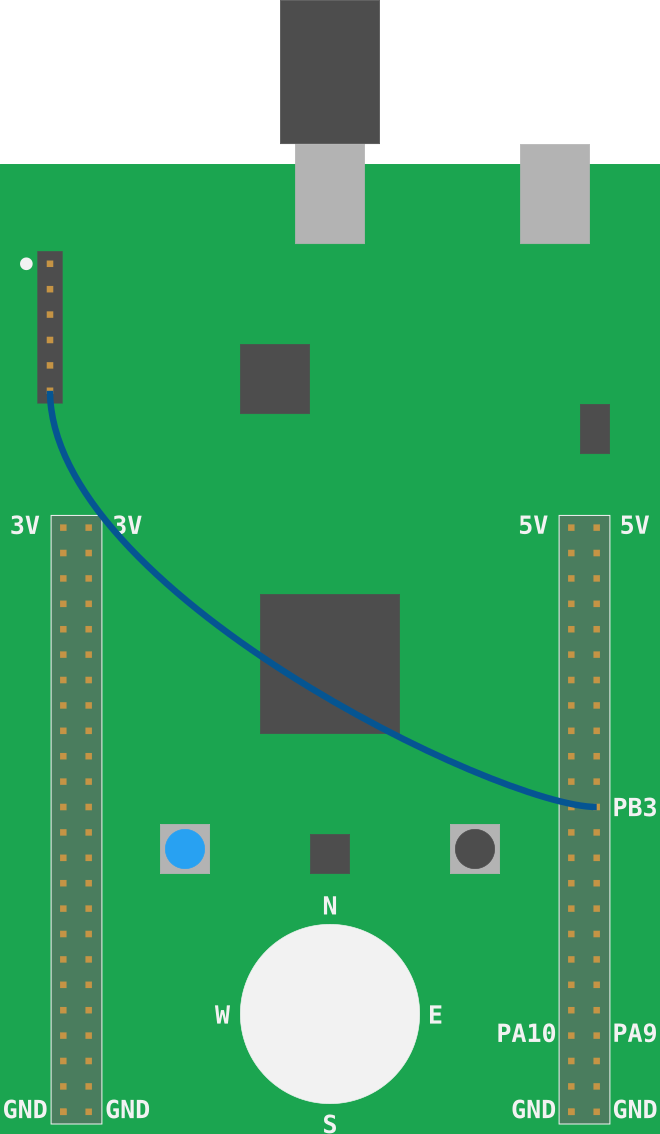Hello, world!
HEADS UP Several readers have reported that the "solder bridge" SB10 (see back of the board) on the STM32F3DISCOVERY, which is required to use the ITM and the
iprint!macros shown below, is not soldered even though the User Manual (page 21) says that it should be.
TL;DR You have two options to fix this: Either solder the solder bridge SB10 or connect a female to female jumper wire between SWO and PB3 as shown in the picture below.

Just a little more of helpful magic before we start doing low level stuff.
Blinking an LED is like the "Hello, world" of the embedded world.
But in this section, we'll run a proper "Hello, world" program that prints stuff to your computer console.
Go to the 06-hello-world directory. There's some starter code in it:
#![deny(unsafe_code)] #![no_main] #![no_std] #[allow(unused_imports)] use aux6::{entry, iprint, iprintln}; #[entry] fn main() -> ! { let mut itm = aux6::init(); iprintln!(&mut itm.stim[0], "Hello, world!"); loop {} }
The iprintln macro will format messages and output them to the microcontroller's ITM. ITM stands
for Instrumentation Trace Macrocell and it's a communication protocol on top of SWD (Serial Wire
Debug) which can be used to send messages from the microcontroller to the debugging host. This
communication is only one way: the debugging host can't send data to the microcontroller.
OpenOCD, which is managing the debug session, can receive data sent through this ITM channel and redirect it to a file.
The ITM protocol works with frames (you can think of them as Ethernet frames). Each frame has a
header and a variable length payload. OpenOCD will receive these frames and write them directly to a
file without parsing them. So, if the microntroller sends the string "Hello, world!" using the
iprintln macro, OpenOCD's output file won't exactly contain that string.
To retrieve the original string, OpenOCD's output file will have to be parsed. We'll use the
itmdump program to perform the parsing as new data arrives.
You should have already installed the itmdump program during the installation chapter.
In a new terminal, run this command inside the /tmp directory, if you are using a *nix OS, or from
within the %TEMP% directory, if you are running Windows. This should be the same directory from
where you are running OpenOCD.
NOTE It's very important that both
itmdumpandopenocdare running from the same directory!
$ # itmdump terminal
$ # *nix
$ cd /tmp && touch itm.txt
$ # Windows
$ cd %TEMP% && type nul >> itm.txt
$ # both
$ itmdump -F -f itm.txt
This command will block as itmdump is now watching the itm.txt file. Leave this terminal open.
Make sure that F3 is connected to your computer. Open another terminal from /tmp directory (on Windows %TEMP%) to launch OpenOCD similar as described in chapter First OpenOCD connection.
Alright. Now, let's build the starter code and flash it into the microcontroller.
To avoid passing the --target thumbv7em-none-eabihf flag to every Cargo invocation we can set a
default target in .cargo/config:
[target.thumbv7em-none-eabihf]
runner = "arm-none-eabi-gdb -q -x openocd.gdb"
rustflags = [
"-C", "link-arg=-Tlink.x",
]
+[build]
+target = "thumbv7em-none-eabihf"
Now if --target is not specified Cargo will assume that the target is thumbv7em-none-eabihf.
$ cargo run
Reading symbols from target/thumbv7em-none-eabihf/debug/hello-world...done.
(..)
Loading section .vector_table, size 0x400 lma 0x8000000
Loading section .text, size 0x27c4 lma 0x8000400
Loading section .rodata, size 0x744 lma 0x8002be0
Start address 0x8002980, load size 13064
Transfer rate: 18 KB/sec, 4354 bytes/write.
Breakpoint 1 at 0x8000402: file src/06-hello-world/src/main.rs, line 10.
Note: automatically using hardware breakpoints for read-only addresses.
Breakpoint 1, main () at src/06-hello-world/src/main.rs:10
10 let mut itm = aux6::init();
Note that there's a openocd.gdb at the root of the Cargo project. It's pretty similar to the one we
used in the previous section.
Before we execute the iprintln! statement. We have to instruct OpenOCD to redirect the ITM output
into the same file that itmdump is watching.
(gdb) # globally enable the ITM and redirect all output to itm.txt
(gdb) monitor tpiu config internal itm.txt uart off 8000000
(gdb) # enable the ITM port 0
(gdb) monitor itm port 0 on
All should be ready! Now execute the iprintln! statement.
(gdb) next
12 iprintln!(&mut itm.stim[0], "Hello, world!");
(gdb) next
14 loop {}
You should see some output in the itmdump terminal:
$ itmdump -F -f itm.txt
(..)
Hello, world!
Awesome, right? Feel free to use iprintln as a logging tool in the coming sections.
Next: That's not all! The iprint! macros are not the only thing that uses the ITM. :-)